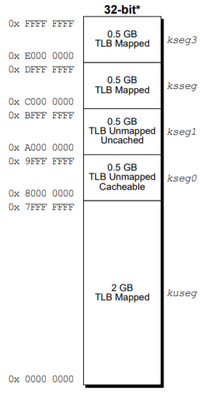Address: Difference between revisions
(Created page with ":''See 'Memory Address' on Wikipedia'' An '''address''' is a number that refers to a specific location in memory. There are 3 main types of addre...") |
(No difference)
|
Revision as of 23:47, 16 May 2021
An address is a number that refers to a specific location in memory. There are 3 main types of addresses in SM64: virtual addresses, physical addresses, and segmented addresses.
Virtual addresses
Virtual addresses are addresses that the N64 can dereference directly. The virtual addressing scheme of the N64's VR4300 CPU looks like this:
| Name | Range (inclusive) | Info |
|---|---|---|
| kuseg | 0x00000000-0x7FFFFFFF | TLB mapped |
| kseg0 | 0x80000000-0x9FFFFFFF | Not TLB mapped; cached |
| kseg1 | 0xA0000000-0xBFFFFFFF | Not TLB mapped; not cached |
| ksseg | 0xC0000000-0xDFFFFFFF | TLB mapped |
| kseg3 | 0xE0000000-0xFFFFFFFF | TLB mapped |
Note that this is the addressing scheme of the CPU when in kernel mode, which the N64 is always meant to run in.
kseg0 and kseg1 are mapped directly onto physical address space; for example, the addresses 0x94A73CF0 and 0xB4A73CF0 would both map to the physical address 0x04A73CF0. In effect, the only difference between kseg0 and kseg1 is that kseg1 isn't cached; this is reflected in the fact that kseg1 addresses are used for hardware register reads and other things that the cache might interfere with.
The TLB mapped sections use the TLB to dynamically map virtual addresses to kseg0/kseg1 addresses.
Physical addresses
Physical addresses run from 0x00000000 to 0x1FFFFFFF. The details of the N64's physical memory mapping can be found here.
Segmented addresses
- Main page: Segment
Segmented addresses are addresses used to reference segmented data. They consist of the 1-byte segment number, which can range from 0x01 to 0x1F (inclusive), and the 3-byte segment offset.
